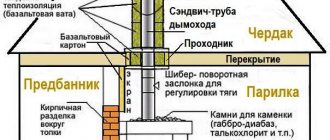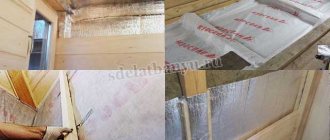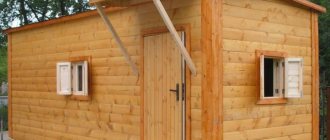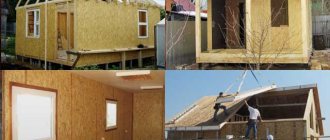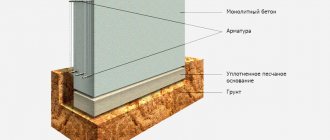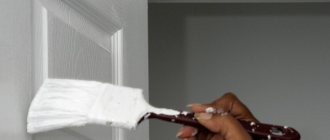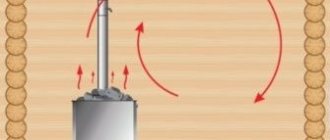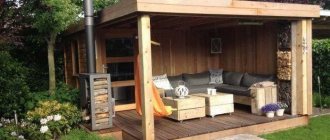High-quality insulation of a steam room in a wooden bathhouse is necessary for the durability of the structure and completeness of sensations, otherwise the effect of the visit may not be entirely pleasant.
There are traditional, historically proven materials for insulating a bathhouse made of timber or logs and modern analogues. With the development of technology, new thermal insulation products are constantly appearing on the market.
When to start insulation and finishing work in a new wooden bathhouse
If the bathhouse is made of timber or is a log house, then you must immediately keep in mind that in the first three years after construction it will shrink noticeably (then less). On average, this is 20 cm in the first 3 years.
During shrinkage, cracks form - all this time you will be patching them. And the most important thing: if finishing was carried out immediately after construction, and it was nailed down firmly, then the lathing will not allow the bathhouse to sit properly.
Therefore, it is either left unfinished, or grooves are cut out in the sheathing so that the nails gradually slide into the grooves.
It’s better not to finish it, because you have to caulk the cracks both inside and outside, and the sheathing will get in the way. The bathhouse needs to be allowed to shrink (at least) for one year. And when its results are already visible, you can think about insulation and finishing work.
How to avoid heat loss
- In houses made of timber, especially logs, there are many places through which cold penetrates into the room, and first of all, these are windows. It is best to install small windows in the bathhouse near the floor, and seal the cracks in them as tightly as possible. It is advisable to use window units with triple glazing.
- Low ceilings, low door frames and high thresholds contribute to heat retention in the steam room.
- It is best to install a door in the dressing room that is insulated with thick felt coated with vinyl.
- An excellent option is to make the entrance to the bathhouse through a closed vestibule.
These tips will help you minimize the entry of cold and keep your interiors as warm as possible.
has been specializing in finishing and insulation of wooden houses for more than ten years. We employ experienced craftsmen who are professionals in their field. We will perform thermal insulation with good quality materials in full accordance with the technology of the work. Entrust our company with the finishing and insulation of your bathhouse, and you will be satisfied with the result.
To contact us, go to the “Contacts” section, where you will find all our coordinates and can leave your request.
Calculate the cost of painting and insulating your home right now
Select types of work:
Select materials:
Inter-crown insulation and sealing of cracks
Over time, wooden buildings inevitably shrink, which causes gaps to appear between the crowns. Those, in turn, open the way for drafts, so the first stage of the fight is to seal them.
The initial stage of interventional insulation occurs during construction. Timber (including profiled) and round timber are laid with tow tape or jute. Subsequently, this will be internal interventional insulation.
In addition to the internal, there is also an external one, which has to be periodically updated. The resulting cracks can be filled with tow, jute, natural moss, or you can use modern materials, but only those designed for wood.
IMPORTANT! Plumbing sealants, putty and polyurethane foam are not suitable for sealing cracks in a bathhouse made of logs or timber. They are inelastic, designed for a constant gap size (while wood changes), they have poor adhesion to wood, insufficient heat resistance, harmful emissions, etc.
flaws. Over time they crumble out of the cracks
They are inelastic, designed for a constant gap size (and in wood it changes), they have poor adhesion to wood, insufficient heat resistance, harmful emissions and other disadvantages. Over time, they crumble out of the cracks.
The cracks on the outside of the beam or log are sealed with wood sealants in such a way that the sealants will dry from 2 to 5 weeks, and the walls must be protected from the sun and rain during this time.
Insulation of bathhouse walls made of wood
As a rule, the walls of the bathhouse are insulated with natural insulation materials based on mineral wool, protected from the effects of water by insulating materials. A lining is placed on top of the insulating layer. The process of insulating walls is very labor-intensive.
Bathroom wall insulation scheme.
- A frame is mounted on the surface of the walls.
- Insulation is placed in the frame.
- The insulation is sheathed with waterproofing foil materials or thick polyethylene film. The canvases are laid overlapping, and the joints are sealed with thin strips. If polyethylene is used, then the joints are welded.
- Final stage. Covering with clapboard or smooth board.
On the market you can purchase thermal insulation materials that combine insulation and waterproofing, which will greatly simplify the insulation of walls. The most popular of these materials is foil foam, which consists of foamed polypropylene covered with aluminum foil. This material is resistant to temperature changes and can withstand up to 1500° C. The use of modern materials makes internal wall insulation more effective.
In order to make thermal insulation with penotherm, you need to be able to choose the right thickness.
For brick walls with a thickness of 25 - 37 cm, a layer of penotherm of 1.0 cm is required, for 37 cm and more - 0.8 cm.
If the bathhouse is wooden, you will need:
- wall thickness 10 - 15 cm - 0.5 cm penotherm;
- wall thickness 15 - 20 cm - 0.3 cm.
Ceiling insulation is carried out last, using technology identical to wall insulation.
Now you know how to insulate a brick bathhouse. Now let's talk about what you may need to insulate this structure, built from wood with your own hands. Over time, wooden walls can dry out and then gaps will appear between them, and as a result, cold air currents will begin to pass into the room. Therefore, even during the construction of the bathhouse, its walls should be insulated using jute fiber.
How to properly insulate a bathhouse using this material? As we said earlier, thermal insulation of this structure must begin during construction work. You will need to insulate each element of the frame, and you will need to compact the jute fiber using a hammer or a special caulk.
- At the first stage of construction work, you will need to lay jute between the logs;
- After the log house is erected, the joints between the timber and the log should also be sealed with jute;
- Seal all joints using caulk or a hammer.
Before insulating a bathhouse, it is necessary to correctly calculate the thickness of the insulation layer
- Brickwork or concrete structure. The types are combined into one category because they relate to inertial buildings with high heat capacity and high permissible moisture accumulation.
External insulation
Wooden structures
The process of thermal insulation of the room in which the bathhouse is located can be divided into two stages - external and internal work (see also the article Insulation of a bathhouse - materials and technologies). Below we will look at how to insulate a bathhouse made from different materials, and we will start, naturally, with the traditional option - a wooden frame.
By and large, wooden baths and saunas were previously not insulated at all. That is, to maintain maximum temperature in them, no additional structures were erected.
However, it is still possible to improve the heat-saving characteristics of a wooden log house:
The main source of heat loss is the gaps between the crowns of the bathhouse
It doesn’t matter whether the frame is made of round timber or timber, over time the wood will dry out and the gaps between the elements will reach several millimeters
We caulk the crowns
- To reduce heat loss during the construction of the bathhouse, we lay a special insulation between the crowns.
- Six months after construction (ideally, the bathhouse is not in use at this time), we additionally caulk all the cracks. To do this, you can use tow, moss or special materials.
- To seal cracks, use a hammer and a special spatula - “caulk”.
Brick structures
Brick baths are easier to insulate, although more expensive thermal insulation materials are used.
- When choosing how to insulate a bathhouse from the outside, many people prefer cheap polystyrene foam, although it is still better to use polystyrene foam boards. Although they are more expensive, they are more durable and durable.
- Before starting insulation, we prime the wall and then install the lower guide profile. We fasten polystyrene slabs on top of the brickwork with plastic dowels, after which we glue the seams with polyurethane foam.
- We glue fiberglass glass onto the polystyrene foam lining, after which we plaster the bathhouse.
Possible external insulation scheme
This method is the simplest, and it is the one that is used most often when doing all the work with your own hands. However, this is not the only technology, and if time and finances allow, you can even install a multi-layer ventilated facade - a diagram of its design is given above.
Materials
On the modern market there is a large number of insulating materials for interior work, with different raw materials and costs.
Traditional
Natural, environmentally friendly sealants are still used in the outback. They have been used to insulate wooden baths and other buildings for hundreds of years.
Such natural materials include:
- flax tow;
- felt;
- moss.
Natural raw materials do not last very long; If it is mainly birds who like to take it away from the outside, then from all sides of the log house the natural seals are attacked by rodents, insects, microorganisms, and fungi. To some extent, impregnation with an antiseptic helps to save the situation. In general, the procedure for insulating a wooden bathhouse with these materials takes a lot of time and gives short-lived results.
Modern
It is more convenient to use mineral wool and synthetic polymers to insulate a wooden bath; they last much longer.
Among artificial insulation for steam rooms, the following types are most popular:
- regular foam;
- extruded polystyrene, which is better known as penoplex;
- expanded polystyrene roof slabs;
- expanded clay flooring materials.
Any type of heat-insulating product must be resistant to ignition, have low thermal conductivity, high heat capacity, and mechanical strength. It is desirable that the insulation be resistant to microbes and atmospheric influences. In all these parameters, mineral wool and expanded clay occupy a high place.
Insulation of a brick bath
To begin with, it should be noted that building a brick bathhouse is much cheaper than building a wooden bathhouse. Based on this, many steam room lovers build a bathhouse from this material. However, you need to know that a brick bathhouse requires not only high-quality insulation, but also additional processing that protects the structure from the effects of water, steam and temperature changes.
The outside of the bath is insulated using various mineral wool insulation materials. This type of insulation is most often sold in rolls, slabs and mats. Rolled mineral wool insulation is used to cover the entire outer surface of the bathhouse walls. It is attached using ordinary wooden planks and slats. If the bathhouse is insulated using slabs, then metal corners should be installed between them, which must match the dimensions of the slabs.
When starting work, you need to take into account that not only the surface of the walls of the bathhouse, but also the entire perimeter of the foundation requires insulation. The finishing on top of the insulation is made from the material preferred by the bathhouse owner
At the same time, a small gap must be maintained between the insulation layer and the external finish - during operation it will serve as ventilation.
In order for the bathhouse to serve for a long time and fully insulate the roof of the building. This is most often done using clay or grass turf. The clay is diluted with water to the state of liquid sour cream and pour a thin layer over the roof surface. After waiting for the first layer to dry completely, pour in the second layer of clay mortar. Then the clay is carefully compacted and covered with material that has high thermal insulation characteristics, for example, sawdust. Tiles are laid on the floor of a brick bathhouse. Additional insulation of the floor is not required - the tile heats up quickly and retains the temperature perfectly.
We insulate the bathhouse from the outside
Insulating does not only mean protecting from blowing. Insulate - ensure conditions for maintaining a stable thermal regime indoors.
For log cabins or when building bathhouses in areas with mild winters, it is quite enough to carry out external insulation of the walls to protect the bathhouse from heat leaks. Inside there is only finishing made from natural materials.
At the same time, it is possible to insulate the walls from the outside immediately after the shrinkage of the log house, based on the thickness of its elements and the density of the crowns.
It is worth remembering that the main heat leaks occur in the corners of the room, so there should be as few joints as possible; they need to be sealed with special care.
The attic is subject to external insulation:
- the ceiling is covered with glass hydrosol;
- it is filled with expanded clay, slag, or mineral mats are laid over the insulator;
- a reinforced or non-reinforced screed is made on top.
For external wall insulation, ventilated facade technology is used:
- a sheathing frame is created along the width of the sheets (mats, slabs) of insulation, exceeding the thickness of the sheets by 3 cm (for the ventilation gap);
- the insulation is laid in the sheathing structure from bottom to top:
- the diffuse membrane is attached to the sheathing with a stapler;
- Facades are faced with varnished lumber, false beams or colored siding.
Particular attention is required to the insulation of the basement, where the cooling of the walls, especially during the cold period, occurs especially intensively.
To do this, formwork is installed around the perimeter of the structure from boards up to half a meter high and 30 cm deep. The formwork cavity is lined with any waterproofing material and filled with soil or expanded clay. The top is covered with a board to prevent erosion by rainwater.
How to insulate the floor in a bathhouse? You will find the answer here. And here is an article about roof insulation in a bathhouse.
On our website you will find a lot of interesting and useful information.
Insulation of a bathhouse made of timber from the outside
External insulation of walls made of timber simultaneously performs the functions of wind and moisture protection:
- First, caulking is done, and the walls are treated with an antiseptic. Then lathing is made or metal guides are attached. Insulation is laid in the gaps. The next layer is wind and moisture protection. This should be a membrane. A counter-lattice or another way to create a ventilation gap of 3-4 cm. A layer of finishing.
External wall insulation (shown using a block wall as an example, but this can be done to insulate any wall).
Insulating a bathhouse made of timber from the outside with mineral wool may only be necessary, perhaps, if this bathhouse is a living space. Well, or if the bathhouse is made of very thin timber and is located in the Far North and is operated in severe frosts. Outside, it is permissible to use mineral wool with phenolic impregnation.
When does insulating a bathhouse from the outside make no sense and when is external wall insulation justified? How to do it?
But still, as a rule, insulation of a bathhouse made of timber from the outside is not required.
Just as in most cases a wooden bathhouse does not need any insulation other than sealing the cracks, its steam room is able to perform its functions without additional effort. Unless the owner sets the task of making a sauna out of a bathhouse, which differ in temperature and air humidity. But even in this case, it is enough to simply lay a layer of foil or foil-coated kraft paper without installing any insulation.
The foil is placed behind the lining, but never end-to-end, but with a ventilation gap so that the lining can dry out. There should also be an air gap between the foil and the timber wall. If a “thermos” is made from a steam room, you should not use coniferous wood in the lining, so as not to get burns from the resin. Let’s put it this way: insulating a steam room in a wooden bath, if we don’t talk about using foil, is a very strange event. The debate about foil will never end , she has many supporters and opponents.
But, as a fact, a steam room with foil becomes hotter, and the steam in it becomes harsher. Therefore, it is a matter of the owner’s taste. On the other hand, mistakes during its installation can be costly; if the wood gets wet, mushrooms and rot will develop. As experts say: try steaming without foil, you will always have time to put it on.
Exterior design of block baths
As for how to insulate a bathhouse from the outside, for a building made of blocks it is allowed to use the same options as in the cases described above. Another way is to decorate the bathhouse building with decorative brickwork, but this method can only be used if the building maintains a constantly above-zero temperature.
If the decision is made to lay out the bathhouse from blocks with bricks, then the additional wall can be made incompletely, retreating by 5-10 centimeters. Thanks to this, the thermal insulation performance will improve somewhat. The gap is either left empty or filled with thermal insulation material - processed sawdust, expanded clay, and so on.
In order to prevent moisture from collecting in the space between the walls, small ventilation gaps are created in the outer walls, and short pieces of fastening reinforcement are driven into the load-bearing walls to securely fix the finishing structure.
Today, the block house is very popular - a finish that imitates a wall made of logs. It is made from various materials: wood, vinyl (PVC), metal. The building, clad in a block house, looks as if it were made of natural wood.
If the question arises about how to insulate an old bathhouse, then the work is carried out in exactly the same way as when building a new one, depending on the material from which it is constructed. Finally, you can cover it with finishing materials, and the building will look attractive again.
Insulating a bathhouse is an important measure, without which it will not be possible to maintain a high temperature in the building. In addition, space heating costs will be reduced. Regarding the problem of how to insulate a wooden bathhouse from the outside, its solution depends on what building material the structure is quickly erected from. The work is simple enough that you can do it yourself. After insulating the bathhouse, all that remains is to complete the finishing using a suitable material - and it is completely ready for use.
Insulation made of synthetic materials for baths made of timber
Synthetic materials for insulating a log bathhouse
Before you start insulating a bathhouse, you should take into account the fact that the use of synthetic materials for these purposes is highly undesirable. This is due to the fact that the bathhouse loses its healing properties. Despite this, each material is worthy of more detailed information.
Mineral wool
The main advantage of this material is that it is completely non-flammable. The disadvantages of mineral wool are its complete lack of durability and too high sensitivity to moisture. It is used not only for thermal insulation of baths, but also in the construction of many other objects. Mineral wool is sold in rolls or sheets. Mineral wool is very convenient and extremely easy to use. The fairly low price also stands out.
Penoizol
Penoizol is an environmentally neutral material that does not accumulate harmful substances. It is very easy and convenient to use, it is durable and reliable. Penoizol is not subject to rotting or burning, and does not attract insects and rodents, which diligently avoid it. Sales are carried out in the form of rolls, crumbly crumbs or sheets.
Expanded polystyrene
This material stands out among others in that it retains heat perfectly, although the thermal insulation indicator strongly depends on the company that produces it. The disadvantage of polystyrene foam is its flammability. When burned, styrene is released, which has slightly toxic properties. The material is durable and quite easy to use. The price of polystyrene foam greatly depends on the manufacturer and the quality of the material.
Polyurethane foam
Among all synthetic materials, polyurethane foam is the leader in thermal insulation properties. That is why baths treated with polyurethane foam are considered warm. This material is extremely durable, but is also highly flammable, releasing highly toxic cyanide. The walls are covered with it in the form of pollination. The price of polyurethane foam largely depends on the manufacturer and quality of the material.
External thermal protection of the bath
Insulation of log and timber houses from the outside always begins with caulking. This work is carried out in several stages:
- at the construction stage;
- after the main shrinkage has passed, a year and a half after the construction of the log house;
- 5-6 years after construction.
Thermal insulation outside the bath
Additional insulation under the bathhouse lining with finishing materials is carried out after secondary caulking. In this case, the third stage of caulking is not required.
For external thermal insulation of a wooden bath, you can use the following materials:
- Expanded polystyrene. It has good thermal insulation characteristics, is lightweight and inexpensive.
- Basalt insulation. The material is non-flammable, resistant to moisture and deformation, and has high thermal and sound insulation performance.
- Mineral wool. It has low thermal conductivity, good hydrophobicity, absorbs noise and sounds.
- Glass wool. An excellent heat insulator and has high vapor permeability.
Insulation materials
Insulation for a timber bath should have vapor permeability characteristics similar to wood. For this reason, all variations on the theme of polystyrene foam disappear - it does not allow moisture to pass through and condensation will form where it touches the wood.
Polyurethane foam emits harmful substances, so it is not suitable.
Mineral wools have suitable vapor permeability and can be freely used for external insulation, but the phenolic impregnations of most types of mineral wool during internal insulation of a bathhouse will evaporate at high temperatures, and these are carcinogens. There is basalt wool, to which no impregnation is added at all or very little is added - it is suitable.
Suitable insulation materials include flax fiber and soft fiberboard. The first consists of 85% flax, the second - from coniferous wood chips.
Both materials are vapor permeable, easily absorb and easily release moisture. Their characteristics are close to wood. But without fire retardant treatment, they are highly flammable.
But ecowool has already been treated with fire retardants, so it does not support combustion, it can be used in a wooden bathhouse.
By
Insulation of roof and ceiling
The roof is one of the largest sources of heat loss, accounting for 20 to 30% of heat loss. Therefore, thermal insulation of the bathhouse roof is a mandatory measure, without which it is impossible to maintain the required temperature in the steam room.
Insulation of the roof of a log house in which there is no attic space is done from the inside; if the bathhouse has an attic, work can be done both from the inside and from the outside. When choosing one or another method of thermal insulation, you need to take into account what kind of insulation will be used.
Mineral wool, penoizol, polystyrene foam can be installed on either side, if bulk or bulk material is used, the work is carried out from the outside.
Bathhouse roof insulation technology:
- Load-bearing floors and other wooden roof elements are treated with an antiseptic. The main attention should be paid to areas where wood comes into contact with other materials: concrete, brick, metal.
- A waterproofing, vapor-permeable membrane is laid over the rafters. It is designed to protect the insulation from moisture and condensation coming from an unheated attic or roof.
- Insulation boards are laid between the ceiling slabs, and the joints between the materials are carefully sealed.
- On the room side, the insulation is covered with a vapor barrier film, which is fixed to the rafters. The seams are taped with mounting tape.
- A sheathing is mounted on top of the film, then the ceiling is sheathed with finishing material.
Thermal insulation of the ceiling with liquid insulation:
- Two layers of fiberglass are laid on top of the rough ceiling. It is necessary to create a barrier to liquid.
- A heat-insulating solution is prepared separately: clay is mixed with chopped straw or sawdust in a 1:1 ratio, then the mixture is filled with water and mixed well.
- The solution is poured between the ceilings.
- The clay should dry well, this will take about 2-3 weeks.
- After complete drying, insulation boards are laid on top of the clay.
- A windproof film is laid on the thermal insulation, and then a cement screed is made.
This method of insulation is one of the most effective; a multi-layer cake does not allow heat to escape and is a good barrier to the cold.
Insulating a timber bath from the inside or outside, whichever is best
The answer to this question depends on what it should be better for: even after caulking, your bathhouse is so cold that no matter how much you heat it, it does not heat up to the required degree, or do you want to be able to steam in it for two days?
In the first case, you need to look for the reason where the heat goes. Alternatively, insulation from the inside can help, although there is an opinion that a wooden bathhouse should not be insulated in this way at all. In the second case, external insulation will help.
IMPORTANT! No matter which side you insulate the bathhouse, there you lose control over the condition of the wood, because it is hidden from view. You can only rely on proper installation of insulation
Wood breathes, takes in and releases moisture, so when insulating, you need to maintain the opportunity for it to “breathe.” And this means great limitations in the materials used.
Bath insulation process
When building a sauna from timber, insulation is necessary if you plan to steam in the winter or the heat emanating from the stove is not enough to heat the steam room to the required temperature. To understand how to insulate a wooden bathhouse, you should study a large number of materials on this topic. This will help to avoid a large number of errors and problems that may arise directly at the stage of installation of thermal insulation materials, which may increase the work time.
The bath is insulated from the inside, outside and inside the wall. In-wall thermal insulation is installed as the walls are being built. A layer of mineral wool or other heat-insulating materials is laid between the inner and outer walls. The bulk of the work on internal insulation is carried out before finishing the interior. The exception to the rule is the floor and attic floors.
Bathroom floor insulation
Before you start insulating the attic floor, you should take care of the vapor barrier. To provide vapor barrier, glass hydroisol, roofing felt or polyethylene are used. The next layer is expanded clay, slag or fiberboard. The main requirements that should be presented to the insulation are: fire resistance, the quality of the thermal insulation layer should be equal to the same value as 25 centimeters of mineral wool. A screed of sand and cement, at least 3 centimeters thick, is laid on top of the heat-insulating layer, on top of which walking boards are laid.
Insulating the steam room of a log bath begins with insulating the walls from the inside. It is recommended to install heat and vapor barrier under materials such as gypsum fiber, plasterboard, magnesite. Undoubtedly, this will reduce the usable area of the room, but the amount of heat retained will significantly increase.
Insulation of the steam room of a bath
Insulation of a wooden bathhouse from the outside begins with insulation of its facade, at the stage of wall construction. To do this, inter-crown insulation is laid between the logs of the log house, which can be either ordinary tow or more modern insulation made from jute and flax. The thickness of the inter-crown for baths made of brace should not be less than 0.5-1 centimeters, and from a log house – 1.5 centimeters.
The optimal time to insulate the facade is mid-summer. During this period there are no sharp, abrupt fluctuations in temperature and humidity. Before you begin work on insulating the facade, it should be treated with agents that protect against rotting processes and prevent fire. If necessary, the inter-crown cracks are caulked. The façade is insulated with mineral wool, polyurethane foam, and polystyrene foam. Each layer of insulation must be secured with anchors, ensuring that the joint below the previous row overlaps the top one, resembling brickwork.
Bathhouse in the process of insulation
To prevent the formation of condensation during changes in temperature and air humidity, vents are provided under the sheathing and in the thickness of the foundation - special ventilation holes through which water vapor is discharged along with ventilation air flows.
To choose the right insulation, you should enlist the help of professionals and learn as much as possible on your own. Before you start insulating a wooden bath, you should plan everything carefully.
Having learned how to insulate a timber bathhouse as a whole, you should dwell in more detail on the most important part. Thermal insulation of the steam room is of greatest importance, because it is important to quickly create and constantly maintain high temperatures (from 60 to 130 degrees Celsius)
In a Russian bath, the optimal temperature is considered to be 60-90 degrees Celsius, since heat is achieved through high humidity, while a Finnish sauna requires higher temperatures, up to 130 degrees Celsius, due to dry air.
The importance of reducing heat loss is that a certain amount of fuel is needed to create the required temperature, and the more heat is lost, the more expensive it will be to light the bathhouse. In addition to this drawback, there is another, more global
Due to high heat losses and the use of large amounts of fuel, the service life of a bathhouse or sauna is significantly reduced, which entails additional costs for repairs and the purchase of fuel.
Ultimately, in some cases, heat loss can exceed heat output, and then the room will not warm up at all. In order to avoid home problems, you should arrange high-quality thermal insulation, which will retain all the healing properties of a real bathhouse, and will also warm up quickly and for a long time, giving warmth to its visitors.
: 2 289
Layout features
In the old rural baths, the exit from the steam room was almost immediately onto the street, which was well remembered by viewers of domestic films in which steamed heroes jump out of the steam room into the snowdrifts.
Modern owners make buildings more spacious, providing not only a steam room, but also a wash room, a dressing room, and a locker room. It is important not to overdo it in this matter, but to make the room after a preliminary calculation of the number of possible visitors. The extra space will increase heat loss, fuel consumption for heating and the volume of materials for insulating the room.
It is appropriate to place the steam room away from the entrance so that cold air does not enter it. At a minimum, you need to make a vestibule in front of the steam room if the area of other rooms at the entrance is planned to be small.
The doors in the bathhouse should not be very wide, but with a mandatory high threshold, because cool air always blows into the gap under the door.
Note! A square room with a stove near the entrance is best heated with steam.
With the correct structure design, insulating a wooden bathhouse is not difficult.
Wooden baths insulated from the outside
The most popular were and remain bathhouses built of wood. The walls of a wooden bathhouse have the ability to “breathe” and therefore perfectly regulate the air humidity in the room. To ensure that the wood from which the bathhouse is built retains its valuable properties, insulation is made using natural materials - flax wool, jute and flax felt, red moss or a mixture of the above materials.
Insulating the walls of a bathhouse from the outside does not require special professional skills. With the help of inter-crown insulation, cracks and gaps are caulked. The most convenient insulation materials are made from flax - they are soft and elastic, thanks to which they lie in an even layer. Insulation with jute will take a little longer - it is hard and brittle.
An important point is that the baths are insulated during the construction process, and not after its completion. The insulation is placed between the logs, which makes the structure not only warmer, but also much more durable and strong. After the roof of the bathhouse has been installed, the resulting gaps and grooves are re-insulated.
We recommend you read additionally: Insulating a brick bath.
How to caulk timber
The properties of several natural materials are most suitable:
1. Since ancient times, builders have used tow to insulate Russian baths and Finnish saunas made of wood. Such popularity is ensured by the fact that tow is a cheap and easy-to-handle material. As it turned out, I myself am able (without having special experience) to insulate the timber walls from the outside using improvised means. Tow is sold in rolls, which further simplifies the installation process. In addition, they also sell improved tow with resin impregnation. It is more moisture resistant and has greater strength. The only drawback of the material is its short service life, so the insulation will have to be repaired from time to time.
2. You can also use moss, which is still used in Siberia. The lack of moss is a rather difficult installation process, which can take several days. In addition, moss that is not impregnated with special compounds can be destroyed by moths.
3. Experts consider the most profitable mixture of flax fibers with jute, called flax-jute felt. This is the most reliable insulation for timber walls. Among the advantages, we can emphasize the high density, which will allow for quick and even organization of seams. Also, one cannot ignore the ease of processing; insects and mold and fungi do not touch it. Jute insulation has excellent heat resistance.
In addition, you can use insulation of the beam with polystyrene foam from the outside, as the most inexpensive method, but the high fire hazard of the material has more than once led to tragic consequences, so this decision should be approached very carefully and only if no other insulation is possible.
Internal insulation
Floor and underground space
Foiled polyethylene foam, kraft paper or glassine can be used for vapor barrier. They protect the insulation layer from getting wet, in addition, a layer of metal foil reflects heat into the room.
We fill up the expanded clay
If you plan to insulate a bathhouse with your own hands, you need to start work from the floor:
- We lay sheets of roofing felt on the concrete base. On top of them we install supporting wooden beams, on which the logs will then be attached.
- Pour a layer of expanded clay onto the roofing felt. The thicker the layer, the warmer the floor in the sauna rooms will be.
- We fix the logs to the support beams, having previously leveled them on the plane using a level.
- Between the logs we lay insulation on the expanded clay - mineral wool or polystyrene foam. In some cases, it is possible to fill the underground space with ecowool, a heat-insulating material based on cellulose fibers.
All that remains is to make a vapor barrier, and you can lay the floors
We cover the heat insulator with a vapor-proof membrane, after which we lay the subfloor.
Ventilated facade method
The instructions below will tell you how to properly insulate the walls in a bathhouse using the ventilated facade method.
- On the external walls of the structure you will need to attach a bracket, which will be represented by metal corners. The space between these corners should be slightly smaller than the width of the sealing material;
- You will then need to lay mineral wool mats between the corners;
- Seal the joints between the plates with special construction tape;
- Then we attach a layer of waterproofing that will protect the cotton wool from moisture;
- And at the end we install additional fasteners, which you will need in the cladding work of the bathhouse facade.
This method of thermal insulation of your building will allow you to cope with several tasks at once. Mineral wool will allow heat not to leave the bathhouse for a long time, and ventilation between the cladding and the heat insulator will help create an air flow that will remove moisture from the room.
Analyzing the issue of how to properly insulate a frame bath, we come to the conclusion that only mineral wool can be the best heat insulator for you, because it has a lot of positive qualities. Of which we can highlight:
- non-flammability of this material;
- low level of thermal conductivity;
- good noise insulation performance;
- environmental friendliness.


